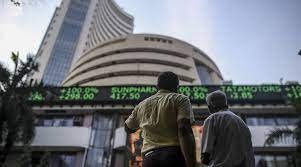The Indian equity benchmark, Sensex, witnessed a strong rally on Wednesday, crossing the significant 63,000 mark. The surge was primarily driven by robust buying in the metal, energy, and FMCG (Fast Moving Consumer Goods) sectors, despite a mixed trend in global equities. The domestic markets also received support from fresh foreign capital inflows and a strengthening rupee, contributing to the overall positive sentiment.
Continuing its upward trajectory for the fourth consecutive session, the 30-share BSE Sensex soared by 350.08 points or 0.56 percent to settle at 63,142.96. In intraday trading, the index reached a high of 63,196.43, registering a substantial gain of 403.55 points or 0.64 percent.
The surge in the metal sector played a significant role in bolstering the Sensex. Metal stocks saw substantial buying interest as investors were optimistic about the sector’s growth prospects. Factors such as increased demand for metals globally, driven by infrastructure development and the revival of industrial activities, contributed to the positive sentiment. Energy stocks also witnessed significant gains as oil prices remained firm, providing a boost to companies in the sector.
Furthermore, the FMCG sector, which includes consumer staples such as food, beverages, and personal care products, witnessed robust buying. The FMCG segment is known for its defensive nature, making it an attractive investment option during uncertain market conditions. With increased consumer spending and a gradual recovery in the economy, investors have shown renewed interest in FMCG stocks.
Traders highlighted the role of fresh foreign capital inflows in supporting the domestic equity markets. The influx of foreign funds into Indian stocks indicates the confidence of international investors in the country’s economic prospects. Positive economic indicators, coupled with government initiatives to attract foreign investment, have contributed to the steady flow of funds into the Indian market.
Moreover, the strengthening of the rupee against major global currencies has further enhanced investor sentiment. A stronger rupee not only attracts foreign investors but also helps contain inflationary pressures by making imports more affordable. This development is seen as a positive sign for the overall health of the Indian economy.
While global equities displayed a mixed trend, the Indian markets managed to maintain their upward momentum. Investors remained cautious due to uncertainties surrounding the global economic recovery, geopolitical tensions, and the trajectory of the COVID-19 pandemic. However, the overall positive sentiment in the Indian market prevailed, driven by domestic factors and a relatively stable economic outlook.
The Sensex’s remarkable climb past the 63,000 mark was fueled by robust buying in the metal, energy, and FMCG sectors. Fresh foreign capital inflows and a strengthening rupee provided additional support to the Indian equity markets. Despite the mixed trend in global equities, the domestic market sustained its positive momentum, reflecting investor confidence in India’s economic prospects. As the markets continue to navigate through uncertainties, investors will closely monitor both domestic and global factors influencing stock performance.




